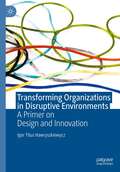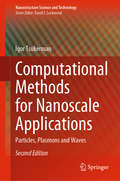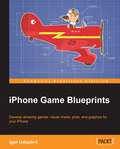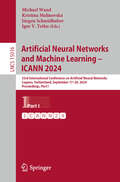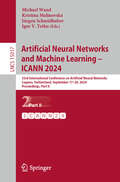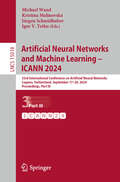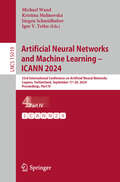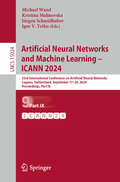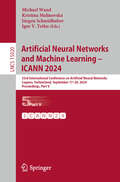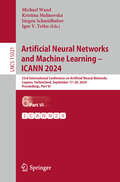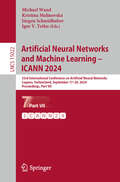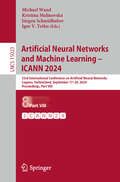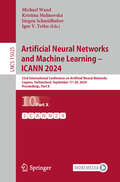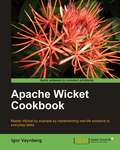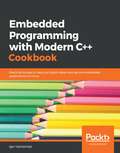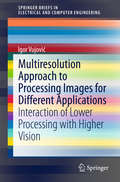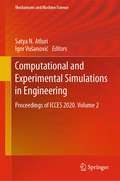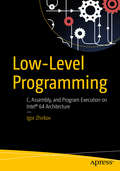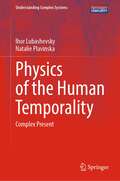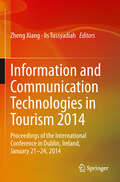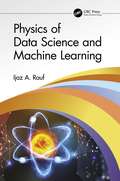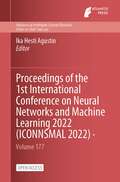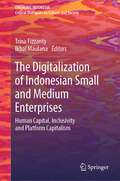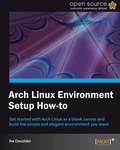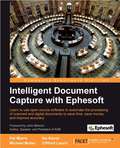- Table View
- List View
Transforming Organizations in Disruptive Environments: A Primer on Design and Innovation
by Igor Titus HawryszkiewyczThis textbook provides a design approach to the topics of innovation and disruption, by drawing on a variety of tools, techniques, and methods, and focusing on solutions that combine data and technology. The premise of the book is the creation of value for the organisations, stakeholders, and community, to enable creative transformation.The book highlights the importance of value and using knowledge to create a seamless roadmap that adds to stakeholder values through best practice business processes that use technology in innovative ways. Written in a clear, simple, and concise manner, avoiding complicated constructions and jargon, the book includes rich illustrations, and summaries and case studies that follow the roadmap at the end of each chapter.
Computational Methods for Nanoscale Applications: Particles, Plasmons and Waves (Nanostructure Science and Technology)
by Igor TsukermanPositioning itself at the common boundaries of several disciplines, this work provides new perspectives on modern nanoscale problems where fundamental science meets technology and computer modeling. In addition to well-known computational techniques such as finite-difference schemes and Ewald summation, the book presents a new finite-difference calculus of Flexible Local Approximation Methods (FLAME) that qualitatively improves the numerical accuracy in a variety of problems.
iPhone Game Blueprints
by Igor UdusliviiiPhone Game Blueprints is a practical, hands-on guide with step-by-step instructions leading you through a number of different projects, providing you with the essentials for creating your own iPhone games.This book is for graphic designers, developers, illustrators, and simple enthusiasts, who dream about the creation of mobile games or who have already worked in that domain, but need some additional inspiration and knowledge. This book can be considered as an illustrated handbook, worth having in your game development studio. It can work as a "paper art-director" for your project.
Artificial Neural Networks and Machine Learning – ICANN 2024: 33rd International Conference on Artificial Neural Networks, Lugano, Switzerland, September 17–20, 2024, Proceedings, Part I (Lecture Notes in Computer Science #15016)
by Igor V. Tetko Jürgen Schmidhuber Michael Wand Kristína MalinovskáThe ten-volume set LNCS 15016-15025 constitutes the refereed proceedings of the 33rd International Conference on Artificial Neural Networks and Machine Learning, ICANN 2024, held in Lugano, Switzerland, during September 17–20, 2024. The 294 full papers and 16 short papers included in these proceedings were carefully reviewed and selected from 764 submissions. The papers cover the following topics: Part I - theory of neural networks and machine learning; novel methods in machine learning; novel neural architectures; neural architecture search; self-organization; neural processes; novel architectures for computer vision; and fairness in machine learning. Part II - computer vision: classification; computer vision: object detection; computer vision: security and adversarial attacks; computer vision: image enhancement; and computer vision: 3D methods. Part III - computer vision: anomaly detection; computer vision: segmentation; computer vision: pose estimation and tracking; computer vision: video processing; computer vision: generative methods; and topics in computer vision. Part IV - brain-inspired computing; cognitive and computational neuroscience; explainable artificial intelligence; robotics; and reinforcement learning. Part V - graph neural networks; and large language models. Part VI - multimodality; federated learning; and time series processing. Part VII - speech processing; natural language processing; and language modeling. Part VIII - biosignal processing in medicine and physiology; and medical image processing. Part IX - human-computer interfaces; recommender systems; environment and climate; city planning; machine learning in engineering and industry; applications in finance; artificial intelligence in education; social network analysis; artificial intelligence and music; and software security. Part X - workshop: AI in drug discovery; workshop: reservoir computing; special session: accuracy, stability, and robustness in deep neural networks; special session: neurorobotics; and special session: spiking neural networks.
Artificial Neural Networks and Machine Learning – ICANN 2024: 33rd International Conference on Artificial Neural Networks, Lugano, Switzerland, September 17–20, 2024, Proceedings, Part II (Lecture Notes in Computer Science #15017)
by Igor V. Tetko Jürgen Schmidhuber Michael Wand Kristína MalinovskáThe ten-volume set LNCS 15016-15025 constitutes the refereed proceedings of the 33rd International Conference on Artificial Neural Networks and Machine Learning, ICANN 2024, held in Lugano, Switzerland, during September 17–20, 2024. The 294 full papers and 16 short papers included in these proceedings were carefully reviewed and selected from 764 submissions. The papers cover the following topics: Part I - theory of neural networks and machine learning; novel methods in machine learning; novel neural architectures; neural architecture search; self-organization; neural processes; novel architectures for computer vision; and fairness in machine learning. Part II - computer vision: classification; computer vision: object detection; computer vision: security and adversarial attacks; computer vision: image enhancement; and computer vision: 3D methods. Part III - computer vision: anomaly detection; computer vision: segmentation; computer vision: pose estimation and tracking; computer vision: video processing; computer vision: generative methods; and topics in computer vision. Part IV - brain-inspired computing; cognitive and computational neuroscience; explainable artificial intelligence; robotics; and reinforcement learning. Part V - graph neural networks; and large language models. Part VI - multimodality; federated learning; and time series processing. Part VII - speech processing; natural language processing; and language modeling. Part VIII - biosignal processing in medicine and physiology; and medical image processing. Part IX - human-computer interfaces; recommender systems; environment and climate; city planning; machine learning in engineering and industry; applications in finance; artificial intelligence in education; social network analysis; artificial intelligence and music; and software security. Part X - workshop: AI in drug discovery; workshop: reservoir computing; special session: accuracy, stability, and robustness in deep neural networks; special session: neurorobotics; and special session: spiking neural networks.
Artificial Neural Networks and Machine Learning – ICANN 2024: 33rd International Conference on Artificial Neural Networks, Lugano, Switzerland, September 17–20, 2024, Proceedings, Part III (Lecture Notes in Computer Science #15018)
by Igor V. Tetko Jürgen Schmidhuber Michael Wand Kristína MalinovskáThe ten-volume set LNCS 15016-15025 constitutes the refereed proceedings of the 33rd International Conference on Artificial Neural Networks and Machine Learning, ICANN 2024, held in Lugano, Switzerland, during September 17–20, 2024. The 294 full papers and 16 short papers included in these proceedings were carefully reviewed and selected from 764 submissions. The papers cover the following topics: Part I - theory of neural networks and machine learning; novel methods in machine learning; novel neural architectures; neural architecture search; self-organization; neural processes; novel architectures for computer vision; and fairness in machine learning. Part II - computer vision: classification; computer vision: object detection; computer vision: security and adversarial attacks; computer vision: image enhancement; and computer vision: 3D methods. Part III - computer vision: anomaly detection; computer vision: segmentation; computer vision: pose estimation and tracking; computer vision: video processing; computer vision: generative methods; and topics in computer vision. Part IV - brain-inspired computing; cognitive and computational neuroscience; explainable artificial intelligence; robotics; and reinforcement learning. Part V - graph neural networks; and large language models. Part VI - multimodality; federated learning; and time series processing. Part VII - speech processing; natural language processing; and language modeling. Part VIII - biosignal processing in medicine and physiology; and medical image processing. Part IX - human-computer interfaces; recommender systems; environment and climate; city planning; machine learning in engineering and industry; applications in finance; artificial intelligence in education; social network analysis; artificial intelligence and music; and software security. Part X - workshop: AI in drug discovery; workshop: reservoir computing; special session: accuracy, stability, and robustness in deep neural networks; special session: neurorobotics; and special session: spiking neural networks.
Artificial Neural Networks and Machine Learning – ICANN 2024: 33rd International Conference on Artificial Neural Networks, Lugano, Switzerland, September 17–20, 2024, Proceedings, Part IV (Lecture Notes in Computer Science #15019)
by Igor V. Tetko Jürgen Schmidhuber Michael Wand Kristína MalinovskáThe ten-volume set LNCS 15016-15025 constitutes the refereed proceedings of the 33rd International Conference on Artificial Neural Networks and Machine Learning, ICANN 2024, held in Lugano, Switzerland, during September 17–20, 2024. The 294 full papers and 16 short papers included in these proceedings were carefully reviewed and selected from 764 submissions. The papers cover the following topics: Part I - theory of neural networks and machine learning; novel methods in machine learning; novel neural architectures; neural architecture search; self-organization; neural processes; novel architectures for computer vision; and fairness in machine learning. Part II - computer vision: classification; computer vision: object detection; computer vision: security and adversarial attacks; computer vision: image enhancement; and computer vision: 3D methods. Part III - computer vision: anomaly detection; computer vision: segmentation; computer vision: pose estimation and tracking; computer vision: video processing; computer vision: generative methods; and topics in computer vision. Part IV - brain-inspired computing; cognitive and computational neuroscience; explainable artificial intelligence; robotics; and reinforcement learning. Part V - graph neural networks; and large language models. Part VI - multimodality; federated learning; and time series processing. Part VII - speech processing; natural language processing; and language modeling. Part VIII - biosignal processing in medicine and physiology; and medical image processing. Part IX - human-computer interfaces; recommender systems; environment and climate; city planning; machine learning in engineering and industry; applications in finance; artificial intelligence in education; social network analysis; artificial intelligence and music; and software security. Part X - workshop: AI in drug discovery; workshop: reservoir computing; special session: accuracy, stability, and robustness in deep neural networks; special session: neurorobotics; and special session: spiking neural networks.
Artificial Neural Networks and Machine Learning – ICANN 2024: 33rd International Conference on Artificial Neural Networks, Lugano, Switzerland, September 17–20, 2024, Proceedings, Part IX (Lecture Notes in Computer Science #15024)
by Igor V. Tetko Jürgen Schmidhuber Michael Wand Kristína MalinovskáThe ten-volume set LNCS 15016-15025 constitutes the refereed proceedings of the 33rd International Conference on Artificial Neural Networks and Machine Learning, ICANN 2024, held in Lugano, Switzerland, during September 17–20, 2024. The 294 full papers and 16 short papers included in these proceedings were carefully reviewed and selected from 764 submissions. The papers cover the following topics: Part I - theory of neural networks and machine learning; novel methods in machine learning; novel neural architectures; neural architecture search; self-organization; neural processes; novel architectures for computer vision; and fairness in machine learning. Part II - computer vision: classification; computer vision: object detection; computer vision: security and adversarial attacks; computer vision: image enhancement; and computer vision: 3D methods. Part III - computer vision: anomaly detection; computer vision: segmentation; computer vision: pose estimation and tracking; computer vision: video processing; computer vision: generative methods; and topics in computer vision. Part IV - brain-inspired computing; cognitive and computational neuroscience; explainable artificial intelligence; robotics; and reinforcement learning. Part V - graph neural networks; and large language models. Part VI - multimodality; federated learning; and time series processing. Part VII - speech processing; natural language processing; and language modeling. Part VIII - biosignal processing in medicine and physiology; and medical image processing. Part IX - human-computer interfaces; recommender systems; environment and climate; city planning; machine learning in engineering and industry; applications in finance; artificial intelligence in education; social network analysis; artificial intelligence and music; and software security. Part X - workshop: AI in drug discovery; workshop: reservoir computing; special session: accuracy, stability, and robustness in deep neural networks; special session: neurorobotics; and special session: spiking neural networks.
Artificial Neural Networks and Machine Learning – ICANN 2024: 33rd International Conference on Artificial Neural Networks, Lugano, Switzerland, September 17–20, 2024, Proceedings, Part V (Lecture Notes in Computer Science #15020)
by Igor V. Tetko Jürgen Schmidhuber Michael Wand Kristína MalinovskáThe ten-volume set LNCS 15016-15025 constitutes the refereed proceedings of the 33rd International Conference on Artificial Neural Networks and Machine Learning, ICANN 2024, held in Lugano, Switzerland, during September 17–20, 2024. The 294 full papers and 16 short papers included in these proceedings were carefully reviewed and selected from 764 submissions. The papers cover the following topics: Part I - theory of neural networks and machine learning; novel methods in machine learning; novel neural architectures; neural architecture search; self-organization; neural processes; novel architectures for computer vision; and fairness in machine learning. Part II - computer vision: classification; computer vision: object detection; computer vision: security and adversarial attacks; computer vision: image enhancement; and computer vision: 3D methods. Part III - computer vision: anomaly detection; computer vision: segmentation; computer vision: pose estimation and tracking; computer vision: video processing; computer vision: generative methods; and topics in computer vision. Part IV - brain-inspired computing; cognitive and computational neuroscience; explainable artificial intelligence; robotics; and reinforcement learning. Part V - graph neural networks; and large language models. Part VI - multimodality; federated learning; and time series processing. Part VII - speech processing; natural language processing; and language modeling. Part VIII - biosignal processing in medicine and physiology; and medical image processing. Part IX - human-computer interfaces; recommender systems; environment and climate; city planning; machine learning in engineering and industry; applications in finance; artificial intelligence in education; social network analysis; artificial intelligence and music; and software security. Part X - workshop: AI in drug discovery; workshop: reservoir computing; special session: accuracy, stability, and robustness in deep neural networks; special session: neurorobotics; and special session: spiking neural networks.
Artificial Neural Networks and Machine Learning – ICANN 2024: 33rd International Conference on Artificial Neural Networks, Lugano, Switzerland, September 17–20, 2024, Proceedings, Part VI (Lecture Notes in Computer Science #15021)
by Igor V. Tetko Jürgen Schmidhuber Michael Wand Kristína MalinovskáThe ten-volume set LNCS 15016-15025 constitutes the refereed proceedings of the 33rd International Conference on Artificial Neural Networks and Machine Learning, ICANN 2024, held in Lugano, Switzerland, during September 17–20, 2024. The 294 full papers and 16 short papers included in these proceedings were carefully reviewed and selected from 764 submissions. The papers cover the following topics: Part I - theory of neural networks and machine learning; novel methods in machine learning; novel neural architectures; neural architecture search; self-organization; neural processes; novel architectures for computer vision; and fairness in machine learning. Part II - computer vision: classification; computer vision: object detection; computer vision: security and adversarial attacks; computer vision: image enhancement; and computer vision: 3D methods. Part III - computer vision: anomaly detection; computer vision: segmentation; computer vision: pose estimation and tracking; computer vision: video processing; computer vision: generative methods; and topics in computer vision. Part IV - brain-inspired computing; cognitive and computational neuroscience; explainable artificial intelligence; robotics; and reinforcement learning. Part V - graph neural networks; and large language models. Part VI - multimodality; federated learning; and time series processing. Part VII - speech processing; natural language processing; and language modeling. Part VIII - biosignal processing in medicine and physiology; and medical image processing. Part IX - human-computer interfaces; recommender systems; environment and climate; city planning; machine learning in engineering and industry; applications in finance; artificial intelligence in education; social network analysis; artificial intelligence and music; and software security. Part X - workshop: AI in drug discovery; workshop: reservoir computing; special session: accuracy, stability, and robustness in deep neural networks; special session: neurorobotics; and special session: spiking neural networks.
Artificial Neural Networks and Machine Learning – ICANN 2024: 33rd International Conference on Artificial Neural Networks, Lugano, Switzerland, September 17–20, 2024, Proceedings, Part VII (Lecture Notes in Computer Science #15022)
by Igor V. Tetko Jürgen Schmidhuber Michael Wand Kristína MalinovskáThe ten-volume set LNCS 15016-15025 constitutes the refereed proceedings of the 33rd International Conference on Artificial Neural Networks and Machine Learning, ICANN 2024, held in Lugano, Switzerland, during September 17–20, 2024. The 294 full papers and 16 short papers included in these proceedings were carefully reviewed and selected from 764 submissions. The papers cover the following topics: Part I - theory of neural networks and machine learning; novel methods in machine learning; novel neural architectures; neural architecture search; self-organization; neural processes; novel architectures for computer vision; and fairness in machine learning. Part II - computer vision: classification; computer vision: object detection; computer vision: security and adversarial attacks; computer vision: image enhancement; and computer vision: 3D methods. Part III - computer vision: anomaly detection; computer vision: segmentation; computer vision: pose estimation and tracking; computer vision: video processing; computer vision: generative methods; and topics in computer vision. Part IV - brain-inspired computing; cognitive and computational neuroscience; explainable artificial intelligence; robotics; and reinforcement learning. Part V - graph neural networks; and large language models. Part VI - multimodality; federated learning; and time series processing. Part VII - speech processing; natural language processing; and language modeling. Part VIII - biosignal processing in medicine and physiology; and medical image processing. Part IX - human-computer interfaces; recommender systems; environment and climate; city planning; machine learning in engineering and industry; applications in finance; artificial intelligence in education; social network analysis; artificial intelligence and music; and software security. Part X - workshop: AI in drug discovery; workshop: reservoir computing; special session: accuracy, stability, and robustness in deep neural networks; special session: neurorobotics; and special session: spiking neural networks.
Artificial Neural Networks and Machine Learning – ICANN 2024: 33rd International Conference on Artificial Neural Networks, Lugano, Switzerland, September 17–20, 2024, Proceedings, Part VIII (Lecture Notes in Computer Science #15023)
by Igor V. Tetko Jürgen Schmidhuber Michael Wand Kristína MalinovskáThe ten-volume set LNCS 15016-15025 constitutes the refereed proceedings of the 33rd International Conference on Artificial Neural Networks and Machine Learning, ICANN 2024, held in Lugano, Switzerland, during September 17–20, 2024. The 294 full papers and 16 short papers included in these proceedings were carefully reviewed and selected from 764 submissions. The papers cover the following topics: Part I - theory of neural networks and machine learning; novel methods in machine learning; novel neural architectures; neural architecture search; self-organization; neural processes; novel architectures for computer vision; and fairness in machine learning. Part II - computer vision: classification; computer vision: object detection; computer vision: security and adversarial attacks; computer vision: image enhancement; and computer vision: 3D methods. Part III - computer vision: anomaly detection; computer vision: segmentation; computer vision: pose estimation and tracking; computer vision: video processing; computer vision: generative methods; and topics in computer vision. Part IV - brain-inspired computing; cognitive and computational neuroscience; explainable artificial intelligence; robotics; and reinforcement learning. Part V - graph neural networks; and large language models. Part VI - multimodality; federated learning; and time series processing. Part VII - speech processing; natural language processing; and language modeling. Part VIII - biosignal processing in medicine and physiology; and medical image processing. Part IX - human-computer interfaces; recommender systems; environment and climate; city planning; machine learning in engineering and industry; applications in finance; artificial intelligence in education; social network analysis; artificial intelligence and music; and software security. Part X - workshop: AI in drug discovery; workshop: reservoir computing; special session: accuracy, stability, and robustness in deep neural networks; special session: neurorobotics; and special session: spiking neural networks.
Artificial Neural Networks and Machine Learning – ICANN 2024: 33rd International Conference on Artificial Neural Networks, Lugano, Switzerland, September 17–20, 2024, Proceedings, Part X (Lecture Notes in Computer Science #15025)
by Igor V. Tetko Jürgen Schmidhuber Michael Wand Kristína MalinovskáThe ten-volume set LNCS 15016-15025 constitutes the refereed proceedings of the 33rd International Conference on Artificial Neural Networks and Machine Learning, ICANN 2024, held in Lugano, Switzerland, during September 17–20, 2024. The 294 full papers and 16 short papers included in these proceedings were carefully reviewed and selected from 764 submissions. The papers cover the following topics: Part I - theory of neural networks and machine learning; novel methods in machine learning; novel neural architectures; neural architecture search; self-organization; neural processes; novel architectures for computer vision; and fairness in machine learning. Part II - computer vision: classification; computer vision: object detection; computer vision: security and adversarial attacks; computer vision: image enhancement; and computer vision: 3D methods. Part III - computer vision: anomaly detection; computer vision: segmentation; computer vision: pose estimation and tracking; computer vision: video processing; computer vision: generative methods; and topics in computer vision. Part IV - brain-inspired computing; cognitive and computational neuroscience; explainable artificial intelligence; robotics; and reinforcement learning. Part V - graph neural networks; and large language models. Part VI - multimodality; federated learning; and time series processing. Part VII - speech processing; natural language processing; and language modeling. Part VIII - biosignal processing in medicine and physiology; and medical image processing. Part IX - human-computer interfaces; recommender systems; environment and climate; city planning; machine learning in engineering and industry; applications in finance; artificial intelligence in education; social network analysis; artificial intelligence and music; and software security. Part X - workshop: AI in drug discovery; workshop: reservoir computing; special session: accuracy, stability, and robustness in deep neural networks; special session: neurorobotics; and special session: spiking neural networks.
Apache Wicket Cookbook
by Igor VaynbergThis is a hands-on practical guide to a large variety of topics and use cases. This book tries to use real-world examples when possible, but is not afraid to come up with a contrived pretext if it makes explaining the problem simpler. Unlike a lot of other books, this one does not try to maintain a continuous theme from chapter to chapter, such as demonstrating solutions on the same fictional application; doing so would be almost impossible given the wide variety of recipes presented here. Instead, this book concentrates on focused problems users are likely to encounter and shows clear solutions in a step-by-step manner. This book tries to teach by example and is not afraid to show a lot of code because, after all, it is for coders. This book is for current users of the Apache Wicket framework; it is not an introduction to Wicket that will bore you with tons of theory. You are expected to have built or maintained a simple Wicket application in the past and to be looking to learn new and better ways of using Wicket. If you are ready to take your Wicket skills to the next level this book is for you.
Embedded Programming with Modern C++ Cookbook: Practical recipes to help you build robust and secure embedded applications on Linux
by Igor ViarheichykExplore various constraints and challenges that embedded developers encounter in their daily tasks and learn how to build effective programs using the latest standards of C++ Key Features Get hands-on experience in developing a sample application for an embedded Linux-based system Explore advanced topics such as concurrency, real-time operating system (RTOS), and C++ utilities Learn how to test and debug your embedded applications using logs and profiling tools Book Description Developing applications for embedded systems may seem like a daunting task as developers face challenges related to limited memory, high power consumption, and maintaining real-time responses. This book is a collection of practical examples to explain how to develop applications for embedded boards and overcome the challenges that you may encounter while developing. The book will start with an introduction to embedded systems and how to set up the development environment. By teaching you to build your first embedded application, the book will help you progress from the basics to more complex concepts, such as debugging, logging, and profiling. Moving ahead, you will learn how to use specialized memory and custom allocators. From here, you will delve into recipes that will teach you how to work with the C++ memory model, atomic variables, and synchronization. The book will then take you through recipes on inter-process communication, data serialization, and timers. Finally, you will cover topics such as error handling and guidelines for real-time systems and safety-critical systems. By the end of this book, you will have become proficient in building robust and secure embedded applications with C++. What you will learn Get to grips with the fundamentals of an embedded system Understand how to optimize code for the targeted hardware platforms Explore cross-compilation, build types, and remote debugging Discover the importance of logging for debugging and root cause analysis of failures Uncover concepts such as interrupt service routine, memory model, and ring buffer Recognize the need for custom memory management in embedded systems Delve into static code analyzers and tools to improve code quality Who this book is for This book is for developers, electronic hardware professionals, and software and system-on-chip engineers who want to build effective embedded programs in C++. Familiarity with the C++ programming language is expected, but no previous knowledge of embedded systems is required.
Multiresolution Approach to Processing Images for Different Applications
by Igor VujovićThis book presents theoretical and practical aspects of the interaction between low and high level image processing. Multiresolution analysis owes its popularity mostly to wavelets and is widely used in a variety of applications. Low level image processing is important for the performance of many high level applications. The book includes examples from different research fields, i. e. video surveillance; biomedical applications (EMG and X-ray); improved communication, namely teleoperation, telemedicine, animation, augmented/virtual reality and robot vision; monitoring of the condition of ship systems and image quality control.
Computational and Experimental Simulations in Engineering: Proceedings of ICCES 2020. Volume 2 (Mechanisms and Machine Science #98)
by Satya N. Atluri Igor VušanovićThis book gathers the latest advances, innovations, and applications in the field of computational engineering, as presented by leading international researchers and engineers at the 26th International Conference on Computational & Experimental Engineering and Sciences (ICCES), held in Phuket, Thailand on January 6-10, 2021. ICCES covers all aspects of applied sciences and engineering: theoretical, analytical, computational, and experimental studies and solutions of problems in the physical, chemical, biological, mechanical, electrical, and mathematical sciences. As such, the book discusses highly diverse topics, including composites; bioengineering & biomechanics; geotechnical engineering; offshore & arctic engineering; multi-scale & multi-physics fluid engineering; structural integrity & longevity; materials design & simulation; and computer modeling methods in engineering. The contributions, which were selected by means of a rigorous international peer-review process, highlight numerous exciting ideas that will spur novel research directions and foster multidisciplinary collaborations.
Low-Level Programming
by Igor ZhirkovLearn Intel 64 assembly language and architecture, become proficient in C, and understand how the programs are compiled and executed down to machine instructions, enabling you to write robust, high-performance code. Low-Level Programming explains Intel 64 architecture as the result of von Neumann architecture evolution. The book teaches the latest version of the C language (C11) and assembly language from scratch. It covers the entire path from source code to program execution, including generation of ELF object files, and static and dynamic linking. Code examples and exercises are included along with the best code practices. Optimization capabilities and limits of modern compilers are examined, enabling you to balance between program readability and performance. The use of various performance-gain techniques is demonstrated, such as SSE instructions and pre-fetching. Relevant Computer Science topics such as models of computation and formal grammars are addressed, and their practical value explained. What You'll Learn Low-Level Programming teaches programmers to: Freely write in assembly language Understand the programming model of Intel 64 Write maintainable and robust code in C11 Follow the compilation process and decipher assembly listings Debug errors in compiled assembly code Use appropriate models of computation to greatly reduce program complexity Write performance-critical code Comprehend the impact of a weak memory model in multi-threaded applications Who This Book Is For Intermediate to advanced programmers and programming students
Physics of the Human Temporality: Complex Present (Understanding Complex Systems)
by Ihor Lubashevsky Natalie PlavinskaThis book presents a novel account of the human temporal dimension called the “human temporality” and develops a special mathematical formalism for describing such an object as the human mind. One of the characteristic features of the human mind is its temporal extent. For objects of physical reality, only the present exists, which may be conceived as a point-like moment in time. In the human temporality, the past retained in the memory, the imaginary future, and the present coexist and are closely intertwined and impact one another.This book focuses on one of the fragments of the human temporality called the complex present. A detailed analysis of the classical and modern concepts has enabled the authors to put forward the idea of the multi-component structure of the present. For the concept of the complex present, the authors proposed a novel account that involves a qualitative description and a special mathematical formalism. This formalism takes into account human goal-oriented behavior and uncertainty in human perception.The present book can be interesting for theoreticians, physicists dealing with modeling systems where the human factor plays a crucial role, philosophers who are interested in applying philosophical concepts to constructing mathematical models, and psychologists whose research is related to modeling mental processes.
Information and Communication Technologies in Tourism 2014
by Zheng Xiang Iis TussyadiahThe papers presented in this volume advance the state-of-the-art research on social media and Web 2. 0, electronic tourism marketing, website development and evaluation, search engine marketing and optimization, IT adoption and diffusion, virtual travel communities, mobile technologies, management information systems in tourism, eLearning, recommender systems for tourism businesses and destinations and electronic distribution for hospitality and travel products. This book covers the most significant topics contributed by prominent scholars from around the world and is suitable for both academics and practitioners who are interested in the latest developments in e-Tourism.
Physics of Data Science and Machine Learning
by Ijaz A. RaufPhysics of Data Science and Machine Learning links fundamental concepts of physics to data science, machine learning and artificial intelligence for physicists looking to integrate these techniques into their work. This book is written explicitly for physicists, marrying quantum and statistical mechanics with modern data mining, data science, and machine learning. It also explains how to integrate these techniques into the design of experiments, whilst exploring neural networks and machine learning building on fundamental concepts of statistical and quantum mechanics. This book is a self-learning tool for physicists looking to learn how to utilize data science and machine learning in their research. It will also be of interest to computer scientists and applied mathematicians, alongside graduate students looking to understand the basic concepts and foundations of data science, machine learning, and artificial intelligence. Although specifically written for physicists, it will also help provide non-physicists with an opportunity to understand the fundamental concepts from a physics perspective to aid the development of new and innovative machine learning and artificial intelligence tools. Key features: Introduces the design of experiments and digital twin concepts in simple lay terms for physicists to understand, adopt, and adapt. Free from endless derivations, instead equations are presented and explained strategically and explain why it is imperative to use them and how they will help in the task at hand. Illustrations and simple explanations help readers visualize and absorb the difficult to understand concepts. Ijaz A. Rauf is Adjunct Professor at the School of Graduate Studies, York University, Toronto, Canada. He is also an Associate Researcher at Ryerson University, Toronto, Canada and President of the Eminent-Tech Corporation, Bradford, ON, Canada.
Proceedings of the 1st International Conference on Neural Networks and Machine Learning 2022 (Advances in Intelligent Systems Research #177)
by Ika Hesti AgustinThis is an open access book. The 1st ICONNSMAL 2022 was held at CGANT Research Group the University of Jember, Jember, East-Java, Indonesia.
The Digitalization of Indonesian Small and Medium Enterprises: Human Capital, Inclusivity and Platform Capitalism (Engaging Indonesia)
by Trina Fizzanty Ikbal MaulanaThis book examines the digitalization of Small and Medium Enterprises (SMEs) in Indonesia and its challenges in the context of an emerging economy and the Covid-19 crisis. During the Covid-19 pandemic, business digitalization became a must for a business to avoid collapse and people saw that digital transformation is a panacea for SMEs to help them survive and revive from the crises. Governments and other stakeholders in many countries including Indonesia have launched policies and programs to support SMEs. Transforming SMEs' conventional businesses into digitalized versions, however, is a complex issue influenced by various factors. These factors encompass both internal changes within the organization and external dynamics in the ecosystem in which they operate. This book, therefore, is a new approach towards understanding the digitalization of SMEs in Indonesia and includes contributions from scholars with different, multi-disciplinary perspectives and demonstrates that digital transformation of SMEs is not all about technology adoption but also involves other aspects such as social, economic, and public governance factors. It discusses opportunities and challenges of digital transformation of SMEs in Indonesia, such as digital talent, financial inclusion, platform capitalism, automation, government’s role, governance, open competition, and inclusive digital economy. The book is of interest to researchers and students of social economics, SMEs and entrepreneurship, human capital research, and economy and governance.
Arch Linux Environment Setup How-To
by Ike DevolderEach task expresses a specific task for setting up an Arch Linux environment. The recipe as a solution is a carefully organized set of instructions to perform the task as efficiently as possible and a discussion on how to apply the solution in different situations. "Arch Linux Environment Set-up" How to is for people wanting to dig deep into a Linux system. By the end of the book you will have basic knowledge how a Linux system is built up, how it boots and a general idea of how it is working. The book also assumes you already know what partitioning is and if you need dual booting you already have some experience with that. For people only trying out Arch Linux the author would suggest following this guide inside a virtual machine.
Intelligent Document Capture with Ephesoft
by Michael Muller Ike KavasWritten in easy to follow manner, this book is a complete guide to Document capture with Ephesoft,This book is intended for information technology professionals interested in installing and configuring Ephesoft for their organization, but it is a valuable resource for anyone interested in learning about document capture in general.
